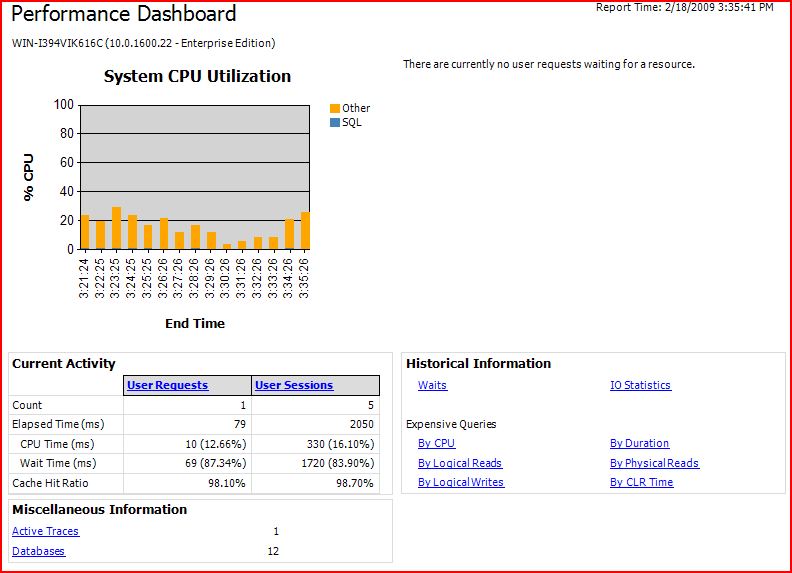Performance Dashboard Reports for SQL Server 2008
During a recent visit to Seattle for a Microsoft conference, I learned from my colleague Michael Thomassy that it's possible to run the SQL Server 2005 Performance Dashboard reports on SQL Server 2008, with a slight modification. There is a great new feature in SQL Server 2008 called Performance Data Collection, which I have blogged about in the past, and this is excellent for tracking SQL Server performance over time across your 2008 estate. There is also the excellent revamped Activity Monitor in SQL 2008. However, if you want to continue to use the Performance Dashboard reports, which many DBA's have found invaluable, they are not supported in SQL Server 2008. If you try to install the Performance Dashboard reports, you get the following error:
Msg 207, Level 16, State 1, Procedure usp_Main_GetCPUHistory, Line 6
Invalid column name 'cpu_ticks_in_ms'.
Msg 15151, Level 16, State 1, Line 1
Cannot find the object 'usp_Main_GetCPUHistory', because it does not exist or you do not have permission.
The reason for this is due to a change in the sys.dm_os_sys_info DMV from SQL Server 2005 to 2008 (the cpu_ticks_in_ms column has been removed in 2008 https://msdn.microsoft.com/en-us/library/ms175048.aspx). Download and install the performance dashboard reports as normal (but save the files in the Program Files\Microsoft SQL Server\100\Tools\PerformanceDashboard directory) and then modify the setup.sql file as shown below before running it against your SQL Server 2008 instance.
Please note that SQL Server 2008 has introduced new wait types that the Performance Dashboard reports currently don't handle. I would strongly recommend using the new Management Data Warehouse reports in SQL Server 2008 in order to get the best user experience. However, this workaround will help you get the Performance Dashboard Reports up and running on your SQL Server 2008 instances (see the screenshot below).
Comments
Anonymous
January 01, 2003
Hi Joe, Yes, I've tested this on SQL Server 2008 64-bit. Thanks for posting the fix for your issue. Cheers, RobAnonymous
January 01, 2003
In Windows 2008 Server Standard Edition SP1 x86 (32 Bits) When i try to run SQL Server 2005 Performance Dashboard Reports in SQL Server 2008 Express Edition SP2 (10.0.4000) x86 (32 Bits) i obtain this error: The file 'Microsoft.ReportViewer.WinForms, Version=9.0.0.0, Culture=neutral, PublicKey Token=b03f5f711d50a3a' cannot be opened. Do you to remove the reference to it from the Recent list? Everyone please tell me how can i solve this? Thanks José Júlio DuarteAnonymous
January 01, 2003
Microsoft SQL Server 2005 Performance Dashboard Reports предназначен для контроля и получения необходимойAnonymous
January 01, 2003
Microsoft SQL Server 2005 Performance Dashboard Reports предназначен для контроля и получения необходимойAnonymous
January 01, 2003
When i try to run SQL Server 2005 Performance Dashboard Reports in SQL Server 2008 R2 x64 i obtain this error: Arithmetic overflow error converting expression to data type int. Everyone please tell me how can i solve this? Thanks José Júlio DuarteAnonymous
January 01, 2003
One of my colleagues, Rob Carrol, has uncovered a way to use the Performance Dashboard Reports on SQLAnonymous
January 01, 2003
When i try to run SQL Server 2005 Performance Dashboard Reports in SQL Server 2008 R2 x64 i obtain this error: Arithmetic overflow error converting expression to data type int. Everyone please tell me how can i solve this? Thanks José Júlio DuarteAnonymous
January 01, 2003
Hello SQLnoob Thank you, it works after i install Report Viewer 2.0 (www.microsoft.com/.../details.aspx) Best regards José Júlio DuarteAnonymous
January 01, 2003
Recently, I learned from a colleague that it's possible to run the SQL Server 2005 Performance DashboardAnonymous
January 01, 2003
During a recent visit to Seattle for a Microsoft TechReady conference, I learned from a colleague thatAnonymous
February 18, 2009
Rob This is great news to the DBAs, it will help to obtain the required reports.Anonymous
March 31, 2009
Have you tried this with SQL 2008 64bit I get a datediff function resulted in overflow error?Anonymous
March 31, 2009
Here is the fix required for the case that you get a datediff causes overflow error: http://theskythelimit.blogspot.com/2008/03/fix-difference-of-two-datetime-columns.htmlAnonymous
September 22, 2009
Hi Also need to apply the fix described in http://blogs.msdn.com/vascov/archive/2008/09/30/using-performance-dashboard-with-sql-server-2008.aspx The current code for 'usp_Main_GetCPUHistory' is seriously flawed.Anonymous
December 30, 2009
To solve the datediff problem just datediff in ss and divide by 1000.Anonymous
September 14, 2010
Thanks a lot for the lovely Post..and many thanks for the Joe Markus For this link :) theskythelimit.blogspot.com/.../fix-difference-of-two-datetime-columns.htmlAnonymous
January 20, 2011
Info on "The file 'Microsoft.ReportViewer.WinForms, Version=9.0.0.0, Culture=neutral, PublicKeyToken=b03f5f7f11d50a3a' cannot be opened. Do you want to remove the reference from the Recent list?" error found here. connect.microsoft.com/.../sql-2008-r2-nov-ctp-management-studio-reports-fail-on-opening Fix: Install Microsoft Report Viewer Redistributable 2008Anonymous
February 08, 2011
The comment has been removedAnonymous
February 09, 2011
The comment has been removedAnonymous
February 09, 2011
The comment has been removedAnonymous
February 09, 2011
The comment has been removedAnonymous
April 11, 2011
Has anyone gotten the error: A data source instance has not been supplied for the data source 'CHECK_DEPENDENCIES'? When I refresh, the error then becomes: The datediff function resulted in an overflow. The number of dateparts separating two date/time instances is too large. Try to use datediff with a less precise datepart. I get this error when clicking on the System CPU Utilization graph.Anonymous
May 13, 2011
I have integrated them to SQL Profiler: sites.google.com/.../sqlprofilerAnonymous
May 24, 2011
The comment has been removedAnonymous
May 30, 2011
Great info Rob, excatly what I was looking...Anonymous
April 24, 2012
social.msdn.microsoft.com/.../ac91f5c2-7547-41a6-ab5b-23e17c1c6816Anonymous
May 23, 2014
Pingback from SQL Server Reports For Management | Click & Find Answer !

